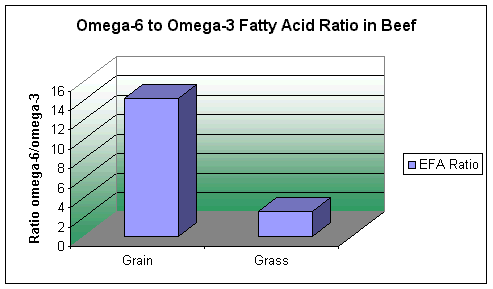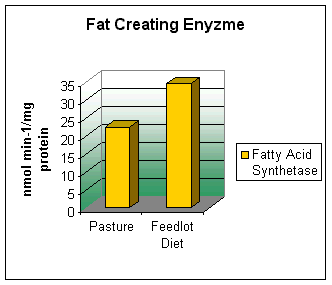|
[?]Subscribe To This Site
|
Desire Weight Loss? Eat Grassfed Recipes
The modern Grassfed Revolution has begun. Weight loss is a natural result of eating grassfed recipes. With today's obesity epidemic, many are trying some system to lose weight that really works. Some are trying the Hoodia system, others the Nutrisystem Program. These and other programs may be helpful. What's needed, however is a weight loss approach that works without having to join a program. To eat meat, milk and eggs from grassfed sources (in other words, eating grassfed recipes) answers this need. Coupled with normal exercise, enjoying grassfed recipes can bring a weight loss breakthrough. Note the following article from the Eatwild website entitled Fat Cows=Fat People
Omega-3 fatty acids are found in greens and omega-6 fatty acids are most abundant in grains. When animals are sent to the feedlot and switched from grass to grain, they have an abrupt shift in fatty acid balance: more omega-6s and fewer omega-3s. This is the recipe for obesity. The cattle put on weight more rapidly on a high-grain diet than they will on a pasture diet, even when they consume exactly the same number of calories. The reason? The omega-6 rich grain diet causes the animals to create more of an enzyme (fatty acid synthetase) that leads to the creation of fat. The graph below shows the difference in the amount of this fat-making enzyme produced in cows on an equal calorie, pasture or feedlot diet.
As you might expect, the meat of the animals also reflected the ratio of fats in their diet. Meat from the grain-fed animals was higher in omega-6 fatty acids and lower in omega-3 fatty acids than the meat from the leaner grassfed animals. Thus, when we eat meat from feedlot animals, we are treated to an abnormally high ratio of omega-6 to omega-3 fatty acids, just like the cattle. In humans, this type of diet is linked with a greater risk of diabetes and obesity, just as it is in livestock. You are what your animals eat. The graph below shows that an animal fattened on grain has 14 times more omega-6 than omega-3 fatty acids in its meat. The grass-fed animal has a ratio of only 2.5, which is considered ideal for human health. Such a ratio is linked with a lower risk of cardiovascular disease, cancer, obesity, diabetes, depression, asthma, and auto-immune disorders. In our efforts to make our animals fatter quicker, we have unwittingly increased our risk of obesity, along with a host of other diseases.

(The study on the fat-producing properties of pasture versus feedlot diets was conducted by Dr. Erasmus Okine at Alberta Agriculture Food and Rural Development in 1997. Read more about it here. To learn more about the omega-6/omega-3 fatty acid balance and obesity in humans, read The Omega Diet by Jo Robinson and Dr. Artemis Simopoulos or refer to the following scientific paper: Storlien, L., D. Pan, et al. (1993). "Skeletal Muscle Membrane Lipid Composition is Related to Adiposity in Man." Obesity Research 1 (Supplement 2): 775. Excerpted with permission from www.eatwild.com, Jo Robinson's website.)
Another hitherto unknown benefit of eating grassfed meat, milk and eggs is muscle growth. Come on over to your local Farmer's Market or health food store and get some grassfed meat or milk. It's a natural approach to weight loss that works!
|
|




 One of the main reasons that cattle are sent to the feedlot is precisely because they get fatter quicker. In the Canadian study represented by the above graph, the animals gained 1.3 kg a day on pasture and 1.55 kg per day on the feedlot diet. (The calories were adjusted so that they were exactly the same.) The end result is that the feedlot animals had more marbling and backfat. In other words, they were more obese. They also got higher grades because the Canadian grading system like the American system is based primarily on fat content. Interestingly, even though the forage-fed cattle received a lower quality grade, their meat was just as tender.
One of the main reasons that cattle are sent to the feedlot is precisely because they get fatter quicker. In the Canadian study represented by the above graph, the animals gained 1.3 kg a day on pasture and 1.55 kg per day on the feedlot diet. (The calories were adjusted so that they were exactly the same.) The end result is that the feedlot animals had more marbling and backfat. In other words, they were more obese. They also got higher grades because the Canadian grading system like the American system is based primarily on fat content. Interestingly, even though the forage-fed cattle received a lower quality grade, their meat was just as tender.